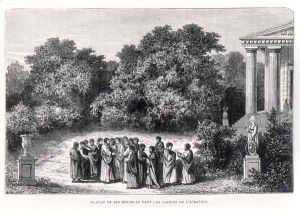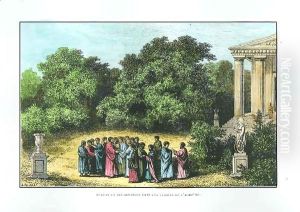Alexandre de Bar Paintings
Alexandre de Bar, born in 1821 and passing in 1908, was a notable French painter associated with the realism movement, which sought to represent subjects truthfully, without artificiality and avoiding artistic conventions, implausible, exotic, and supernatural elements. Although not as widely recognized as his contemporaries like Gustave Courbet or Jean-François Millet, de Bar's work nonetheless played a significant role in the development of realism in French art during the 19th century. His contributions to the art world are marked by a focus on the everyday life of his subjects, often imbuing his works with a sense of immediacy and intimacy that was somewhat ahead of his time.
De Bar's early life was rooted in the French countryside, a setting that would profoundly influence his artistic direction. Unlike many of his peers who were drawn to the urbanity of Paris, de Bar found a ceaseless source of inspiration in rural life, its people, and landscapes. This connection to the land and its inhabitants would define his oeuvre, setting him apart from artists who primarily focused on urban scenes or historical and mythological subjects. His education in art was traditional, studying at the École des Beaux-Arts in Paris, where he was exposed to the teachings of established artists and academics. However, de Bar's style diverged from the neoclassical and romantic traditions that dominated the academy, steering instead towards a more observational, realist approach.
Throughout his career, de Bar exhibited his works in various salons and galleries, gradually gaining recognition for his unique perspective and technique. His paintings often depicted the simplicity and hardship of rural life, avoiding romanticization or dramatization. Instead, de Bar sought to convey the dignity and resilience of his subjects, employing a muted palette and meticulous attention to detail that lent his scenes a profound sense of authenticity.
Despite his contributions, Alexandre de Bar did not achieve the same level of fame as some of his realist counterparts during his lifetime. His dedication to realism was unwavering, even as the art world began to shift towards Impressionism and beyond. In the years following his death in 1908, de Bar's work received renewed interest, particularly among art historians and collectors who appreciated his commitment to portraying the unvarnished realities of life. Today, Alexandre de Bar is recognized for his role in the broader narrative of 19th-century French art, celebrated as a committed realist who captured the essence of rural existence with sensitivity and depth.

